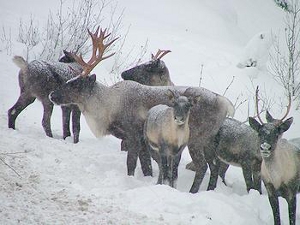|
Thousands of
acres proposed for caribou habitat |
|
December 3, 2011 |
 The
U.S. Fish and Wildlife Service this week
announced a proposal to designate critical
habitat for southern Selkirk Mountains caribou,
an endangered woodland mammal protected under
the Endangered Species Act. The
U.S. Fish and Wildlife Service this week
announced a proposal to designate critical
habitat for southern Selkirk Mountains caribou,
an endangered woodland mammal protected under
the Endangered Species Act.
The southern Selkirk Mountains caribou was
listed as an endangered species in 1984. It
occurs in the Selkirk Mountains of northern
Idaho and northeastern Washington and British
Columbia, and the entire distinct population
segment is estimated to include about 46
animals.
In total, approximately 375,562 acres are being
proposed for designation as critical habitat.
The proposed critical habitat is located in
Boundary and Bonner counties in Idaho, and Pend
Oreille County in Washington.
These lands are all currently considered to be
occupied by the species, and no exclusions are
proposed.
“This proposed critical habitat designation is
required under the ESA, and it is the first of a
two-step process. The Service seeks to gain as
much information as possible from all interested
parties in this step. We do encourage our
federal, state and tribal partners, and others,
to provide comments specific to this proposal,”
said Brian Kelly, Idaho State Supervisor for the
Service.
The primary threat to the species’ survival is
the loss of contiguous old growth forest
habitats due to timber harvest and wildfires.
Human activities such as road-building and
recreational trails can also fragment caribou
habitat and facilitate the movement of predators
into the caribou’s range.
In 1980, the Service received petitions to list
the South Selkirk populations of caribou as
endangered from the Idaho Department of Fish and
Game and a U.S. Forest Service staff biologist.
The southern Selkirk Mountains population of
woodland caribou was emergency listed as
endangered in northeast Washington, northern
Idaho and southeast British Columbia in 1983,
with a final listing in 1984.
Defenders of Wildlife, The Lands Council,
Selkirk Conservation Alliance, and Center for
Biological Diversity petitioned the Service to
designate critical habitat for the species in
2002. A 2009 Settlement Agreement stipulated
that the Service would submit a proposed
critical habitat rule to the Federal Register on
or before Nov. 20, 2011, with a final rule by
Nov. 20, 2012.
The southern Selkirk Mountains caribou is a
member of the deer family, and it possesses
unique biological and behavioral traits. It
prefers high elevations above 4,000 feet and
steep terrain with old-growth forests.
Small groups of mountain caribou migrate
seasonally up and down mountain ranges, rather
than undertaking the mass-group, long-distance
migrations some species of caribou are known
for. When winter snow deepens, mountain caribou
feed almost exclusively on arboreal lichens that
occur on old trees (typically 125 years or
older), in high elevation forests.
Under the ESA, critical habitat identifies
geographic areas that contain features essential
for the conservation of a listed species.
Critical habitat receives protection under
section 7 of the ESA by requiring federal
agencies to consult with the Service on federal
actions that may affect critical habitat and by
prohibiting federal agencies from carrying out,
funding, or authorizing the destruction or
adverse modification of critical habitat. Only
actions that have some federal nexus are subject
to consultation on critical habitat; activities
undertaken by private landowners that do not
involve any federal funding, permits or other
activities are not affected by a critical
habitat designation.
The designation of critical habitat does not
affect land ownership or establish a refuge,
wilderness, reserve, preserve or other
conservation area. It does not allow government
or public access to non-federal lands. A
critical habitat designation does not impose
restrictions on non-federal lands unless federal
funds, permits or activities are involved.
However, designating critical habitat on federal
or non-federal lands informs landowners and the
public of the specific areas that are important
to the conservation of the species. |
|
Questions or comments? Click
here to
email! |
|
|
|
|

